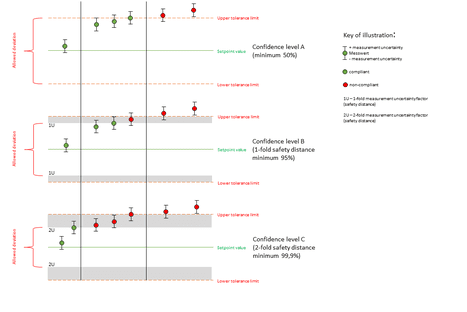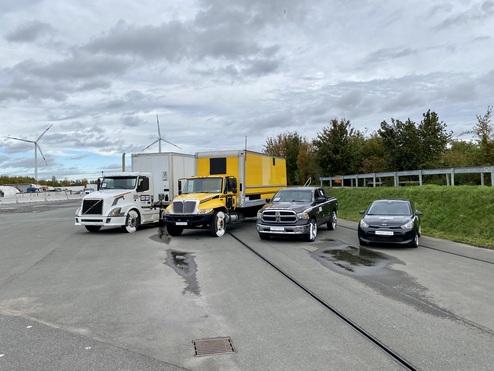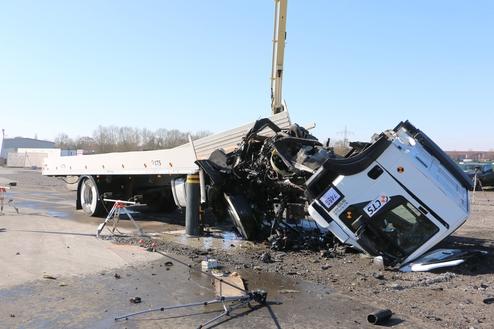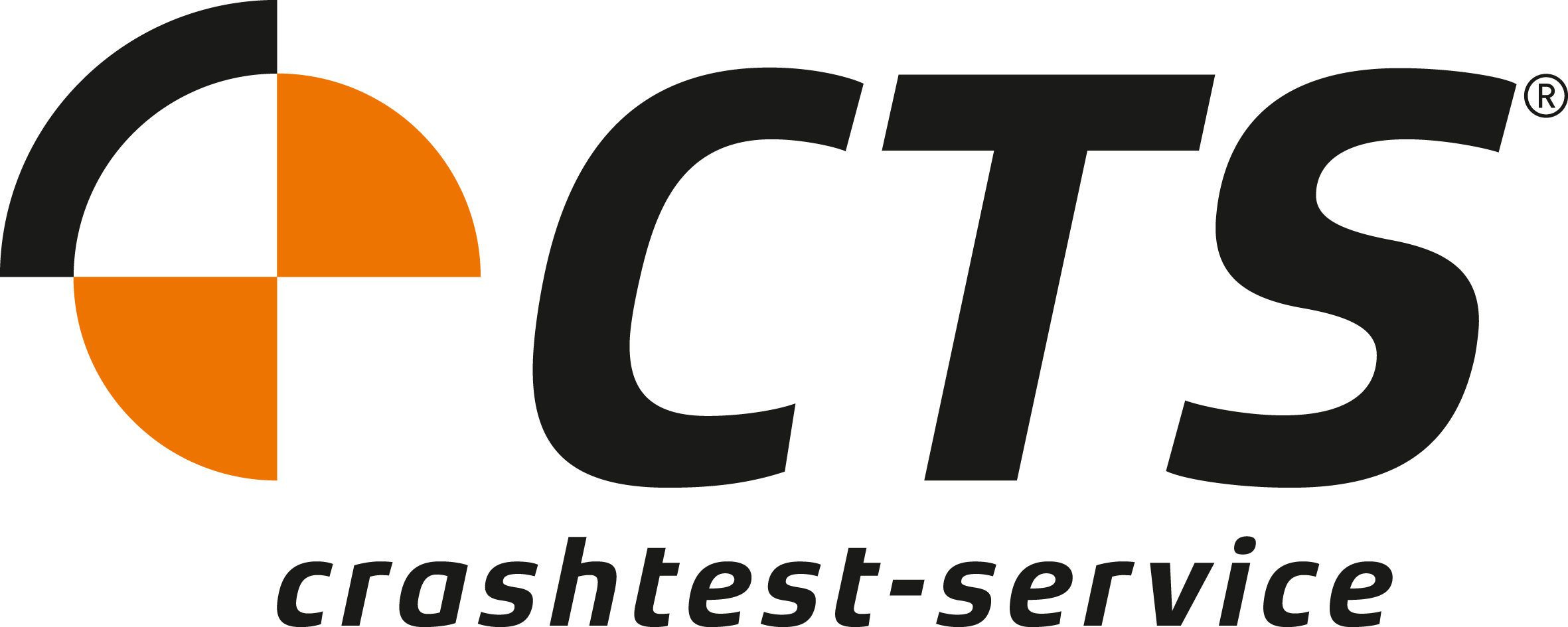Standard crash tests
Tests according to standardized impact tests
As an accredited testing laboratory, we conduct standard-compliant crash tests – specifically for Hostile Vehicle Mitigation, HVM. These include:
- Testing of road restraint systems
DIN EN 1317-1 (2011-01) - Road restraint systems – Part 1: Terminology and general criteria for test methods
DIN EN 1317-2 (2011-01) - Road restraint systems – Part 2: Performance classes, impact test acceptance criteria and test methods for safety barriers including vehicle parapets
DIN EN 1317-3 (2011-01) - Road restraint systems – Part 3: Performance classes, impact test acceptance criteria and test methods for crash cushions
DIN CEN/TS 1317-7 (2024-04) - Road restraint systems - Part 7: Performance characterisation and test methods for terminals of safety barriers
DIN CEN/TS 1317-9 (2024-04) - Road restraint systems - Part 9: Impact tests and test methods for removable barrier sections
DIN CEN/TS 1317-10:2023 - Road restraint systems - Part 10: Assessment methods and design guidelines for transitions, terminal and crasg cushion connections - transitions
DIN CEN/TS 16786 (2018-06) - Restraint systems on roads - Transport vehicle-supported mobile impact retarders (TMA) - Performance classes, acceptance criteria for impact tests and test performance
MASH (2016) - Manual for Assessing Safety Hardware Second Edition only: Longitudinal Barriers, Terminals and Crash Cushions, Truck- and Trailer-Mounted Attenuators and Variable Message Sign and Arrow Board Trailers
- Testing of support structures for road equipment
DIN EN 12767 (2019-10) - Passive safety of support structures for road equipment – Requirements, classification and test methods
MASH (2016) - Manual for Assessing Safety Hardware Second Editiononly: Support Structures, Work-Zone Traffic Control Devices, Breakaway Utility Poles, and Longitudinal Channelizers
- Testing of vehicle security barrier systems
ASTM F2656/F2656M - 23 (2023) - Standard Test Method for Crash Testing of Vehicle Security Barriers
DIN SPEC 91414-1 (2021-04) - Mobile Fahrzeugsicherheitsbarrieren für Sicherheitsanforderungen - Teil 1: Anforderungen, Prüfmethoden und Leistungskriterien
ISO 22343-1 “Security and resilience - Vehicle security barriers - Part 1: Performance requirement, vehicle impact test method and performance rating”
Technical Guideline (TR) (2019-06) – Mobile Vehicle Security Barriers (version 0.8)
Note: ISO 22343-1 has replaced IWA 14-1 since 2023 and PAS 68 was also withdrawn in 2023.
- Testing of safety equipment for construction sites
Technische Lieferbedingungen für Leit- und Warnbaken (1997) - Kapitel 4.1 Prüfung der Folien ausgeschlossen
The requirements of a test laboratory correspond in accordance with Article 43 of the Construction Products Regulation for the EN 1317 test methods. In addition, our accreditation by the DAkkS is internationally valid, since the German accreditation body is a member of the International Laboratory Accreditation Cooperation (ILAC).
Flexible accreditation
Due to the flexible category B accreditation, we can use the free choice of standardized test methods or those that are equivalent to them within the test areas specified above and without requiring prior information and approval from the DAkkS (except EN 1317).
Possible test procedures:
CEN/TS 17342:2019 Road restraint systems - Motorcycle road restraint systems which reduce the impact severity of motorcyclist collisions with safety barriers
ASTM F 3016/F 3016M:2019 - Standard Test Method for Surrogate Testing of Vehicle Impact Protective Devices at Low Speeds
BASt - Sonderlösungen von Schutzeinrichtungen in Einmündungsbereichen (Version 03 vom 23.07.2021)
AS/NZS 3845.2:2017 - Road safety barrier systems and devices Part 2: Road safety devices
BSI PAS 170-1 - Impact testing for vehicle safety barriers - Low speed impact testing Part 1: Test method for bollards using ramming trucks
Withdrawn test procedures:
NCHRP Report 350 - National Cooperative Highway Research Program
MASH 2009 - Manual for Assessing Safety Hardware
Manual for the evaluation of safety devices
ASTM F 2656-07 – Test Methods for Impact Testing of Vehicle Safety Barriers (Formerly P1, P2, P3, P4 Rating)
ASTM F2556/F2656M – 15 - Test Methods for Impact Testing of vehicle safety barriers (formerly P1, P2, P3 rating)
ASTM F2656/F2656M – 18 - Test Methods for Impact Testing of Vehicle Safety Barriers (Formerly P1, P2, P3 Rating)
ASTM F2656/F2656M – 18a - Test Methods for Impact Testing of Vehicle Safety Barriers (Formerly P1, P2, P3 Rating)
ASTM F2656/F2656M – 20 - Test Methods for Impact Testing of Vehicle Safety Barriers (Formerly P1, P2, P3 Rating)
CEN CWA 16221:2010 – Vehicle security barriers. Performance requirements, test methods and guidance on application
DoS SD-STD-02.01 – … (Formerly K4, K8, K12 Rating)
IWA 14-1:2013 – Vehicle security barriers - Part 1: Performance requirement, vehicle impact test method and performance rating
PAS 68:2013 – Impact test specifications for vehicle security barrier systems
DIN V ENV 1317-4 (2002-04) - Road restraint systems –Part 4: Performance classes, impact test acceptance criteria and test methods for terminals and transitions of safety barriers
Fast and flexible
Our large, easily accessible crash test facility, which can be converted in a very short time, offers the highest spatial and technical flexibility. On the new asphalt surface, construction lengths of up to 170 m are now possible, both for transportable systems and for systems attached to asphalt or concrete foundations.

Clear processing of audit reports
- Extensive written and digital documentation of the results
- Multimedia presentation comprehensible for all target groups
- Direct further use for the corresponding certification and approval processes

With regard to compliance statements in test reports, the following decision rules have been defined:
As a rule, a low confidence level (A) is assumed, which increases the acceptance range, so that measurement results with a confidence level of at least 50% are also accepted.
After prior agreement, the customer can also specify a medium confidence level (B), which reduces the acceptance range so that measurement results with a confidence level of at least 95% are also accepted with a maximum residual risk of 5%.
A high confidence level (C), which corresponds to a confidence level of at least 99.9%, is not acceptable at the CTS test laboratory and is therefore not applicable.
The confidence level you set (A or B) will be communicated to you via the offer and the test report.
If a decision rule is included in the applicable rule set/assessment procedure or is specified by the customer, such rules shall take precedence over our general decision rule (confidence level A).
Customized constructive special solutions
- Push-pull tests
- Exchangeable bottoms
- Slopes
- Strip foundations
For your project
We are well equipped for your project
Construction machinery:
- Forklift
- Excavator
- cherry picker
- Vibratory feeder
Equipment / Service:
- Livestreams directly from the crash test facility
- Office container as workplace directly on the crash site
- State-of-the-art meeting rooms
- Catering for you and your customers
- Area-wide W-Lan on the crash test site
News

MASH 2016
For several years now, CTS has been offering MASH 2016 tests from the small Small Car (1100C) and Pickup Truck (2270P), as well as a Single-Unit Van Truck (10000S) to the large Tractor/Van Trailer (36000V).
You can find our successfully tested vehicle restraint systems under the following link on the FHWA homepage:
Do you also have vehicle restraint systems that you would like to market internationally? Please feel free to contact us:

Criteria for the assessment of the hazard potential to motorcyclists from sharp-edged components of road restraint systems
BASt report V374 for the FE project 03.0514
This study examines vehicle restraint systems and their components in detail with regard to their potential hazard to MTWV riders. The focus is particularly on sharp-edged construction parts that can reach MTWV riders during an accident whether the rider is still sitting on the MTWV, is sliding on the ground or is airborne.
To the report
https://bast.opus.hbz-nrw.de/frontdoor/index/index/docId/2813
To the documentation
https://www.bast.de/DE/Verkehrstechnik/Qualitaetsbewertung/Qualitaetsbewertung_node.html
To the videos

ISO 22343-1 standard replaces IWA14-1 and IWA14-2
CTS now offers the following new test procedure:
ISO 22343-1 “Security and resilience - Vehicle security barriers - Part 1: Performance requirement, vehicle impact test method and performance rating”
IWA 14-1:2013 will be replaced by ISO 22343-1:2023 and PAS 68:2013 will only be offered upon explicit customer request.
CTS was involved in the development of the new standard and will be offering tests according to the new international standard from October 2023.
Please feel free to contact us to have your products tested this year so that you can use your product, for example. at Intersec on the 16th.-18th. January 2024 in Dubai.
At the same time, ISO 22343-2 “Security and resilience - Vehicle security barriers – Part 2: Application” was published and replaces IWA 14-2:2013.
Your contact persons
Book your crash appointment easily online!
We look forward to hearing from you.
Let us know your preferred date and your requirements. The CTS team will contact you as soon as possible.


